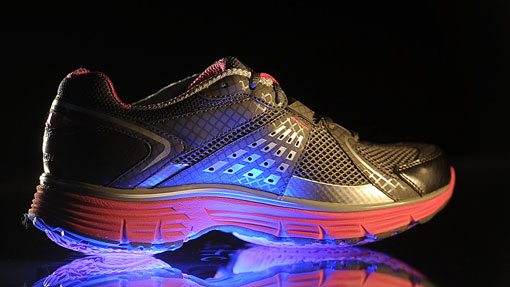UAB Exercise Physiologist Evaluates Popular “Toning” Shoes
By Matt Windsor

When UAB exercise scientist Jane Roy, Ph.D., sees the sexed-up commercials for new “toning” shoes from the likes of Reebok and Skechers, she can’t help but think about something a little less attractive: ankle weights.
Toning shoes feature a curved sole that is intended to re-create the instability of walking on a less stable surface, like sand. Forcing the body to overcome that instability, shoe manufacturers claim, turns a normal walk into a whole-body workout capable of sculpting the legs, bottom, and chest. (These areas get far more screen time in commercials than the shoes themselves.)
The slick ads and celebrity endorsements have fueled blockbuster sales—toning shoes are now the fastest-growing corner of the athletic shoe market. But despite all the hype, the craze is reminiscent of “the ankle-weight fad of the 1980s and ‘power walkers’ swinging hand weights,” Roy says. For modern toning shoes and their fitness cousins, the idea is the same, she notes: “to make movement more difficult and challenging, and to increase energy expenditure.”
(Story continues below the video)
Something in the Way You Move?
But research conducted over the past few decades showed that “there is no conclusive additional benefit to using hand and ankle weights while you work out,” Roy says. “If you were walking, the ankle weights probably prevented you from running. And it turns out there are more benefits from moving faster, at a higher intensity, versus adding that extra weight.” The weights also were jarring on the joints, Roy adds.
Based on her reading of the available research on the new toning shoes, Roy says she has similar concerns. “If you want to burn calories and increase muscle mass, you have to stress the body by working against a load greater than it is used to,” she says. “If these shoes are doing that, you probably will see some benefits. But the research that has been done—much of it supported by shoe manufacturers with very small sample sizes, is inconclusive as to whether the advertised claims are indeed true.”
Shoe manufacturers make much of the analogy to the muscle-strengthening effects of walking on sand, Roy says. “But everyone knows that when you walk on sand, you walk more slowly than you could on a hard surface. The advantage of training on a harder surface is that you can increase your speed and get your heart rate up a lot higher.”
Feel the Burn
There is no good research data to back up the claims by some manufacturers that their shoes improve posture, Roy adds. In fact, the unstable base of support offered by the shoes could exacerbate hip or back pain in some individuals, she points out. In February 2011, an Ohio woman sued shoe maker Skechers, claiming that its product caused stress fractures in both of her hips. And in September 2011, shoe maker Reebok agreed to pay $25 million to settle charges of false advertising brought by the Federal Trade Commission, which took issue with Reebok's claims about the physical benefits of wearing its products.
For certain people, however, the high-tech shoes may be a good fit. “It comes down to personal preference,” Roy says. Although she doesn’t own a pair herself, Roy says if she were in a profession such as nursing, “where you’re on your feet all day,” she might be tempted by the possible toning benefits offered by the shoes.
“If it works for you and you notice a difference and they’re comfortable, then go ahead and wear them,” Roy says. “But don’t forget about the brisk walking/jogging/running, gym work, lunges, and other exercises that have been proven to strengthen the muscles of the legs and ankles.”